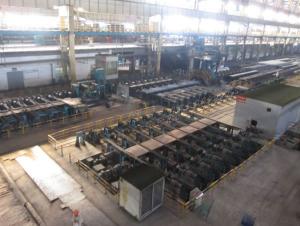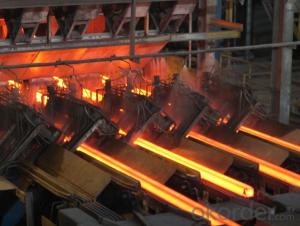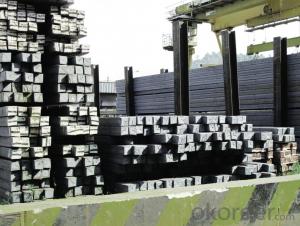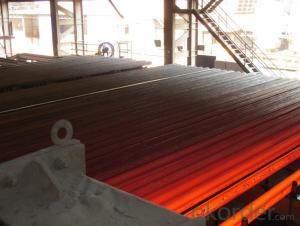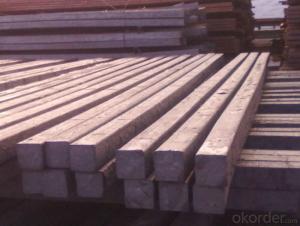Prime square alloy steel billet 90mm Q235
- Loading Port:
- Shanghai
- Payment Terms:
- TT OR LC
- Min Order Qty:
- 100 m.t.
- Supply Capability:
- 10000 m.t./month
OKorder Service Pledge
OKorder Financial Service
You Might Also Like
Structure of Prime square alloy steel billet 90mm Q235

Description of Prime square alloy steel billet 90mm Q235
1. Prepainted steel coil is coated with organic layer, which provides higher anti-corrosion property and a longer lifespan than that of galvanized or galvalume steel sheets.
2. The base metals for prepainted steel coil consist of cold rolled, HDGI Steel, electro-galvanized and hot-dip alu-zinc coated steel. The finish coats of prepainted steel coil can be classified into groups as follows: polyester, silicon modified polyesters, polyvinylidene fluoride, high-durability polyester, etc.
3. The production process has evolved from one-coating-and-one-baking to double-coating-and-double-baking, and even three-coating-and-three-baking.
4. The color of the prepainted steel coil has a very wide selection, like orange, cream-colored, dark sky blue, sea blue, bright red, brick red, ivory white, porcelain blue, etc.
5. The prepainted steel coils can also be classified into groups by their surface textures, namely regular prepainted sheets, embossed sheets and printed sheets.

Main Feature of Prime square alloy steel billet 90mm Q235
1. Thickness: ≥20μm
2. Pencil Hardness: 2H
3. 60° specular glossiness of coating: >60
4. 180°bend: ≤3T
5. Impact: ≥9J
6. Salt Fog Resistant: ≥500h
7. Color difference:<0.8δe< span="">
Applications of Prime square alloy steel billet 90mm Q235
Manufacture Progress:HRC-CRC-GALVANIZED-COLOR COATED
Application : Construction, electrical, transportation, steel plant, composite board plant, steel tile factory
Payment & Shipping Terms:T/T ,L/C, and FOB CHINA
Minimum Order Quantity: 25Tons
Packge Type: Moisture-proof paper inner,Steel outside,Bundle by steel rope.
Package in Container : Wood as a foot pad, wire rope reinforcement,PPGI steel coil tied together by steel rope.

Specifications of Prime square alloy steel billet 90mm Q235
Product | Billet |
Material Grade | SGCC / SGCH / DX51D+AZ, etc |
Thickness | 0.6-3.0mm |
Width | 500-1500mm |
Tolerance | Thickness: +/-0.02mm , Width:+/-2mm |
Zinc-coating | Z30-150g/m2 |
Technique | Raw material: Hot rolled steel coil --> Cold rolled_>hot dipped galvalume |
Surface | Dried, Chromated, Unoiled |
Spangle | Regular spangle , small spangle, zero spangle |
ID | 508MM 610MM |
Coil weight | 1-25MT |
Export package | Cardboard inner sleeves, Waterproof paper, galvanized steel covered and steel strip packed |
FAQ of Prime square alloy steel billet 90mm Q235
We have organized several common questions for our clients,may help you sincerely:
1. How Can I Visit There?
Our company is located in Tianjin City, China, near Beijing. You can fly to Tianjin Airport Directly. All our clients, from home or aboard, are warmly welcome to visit us!
2. How Can I Get Some Sample?
We are honored to offer you sample.
3. Why choose CNBM?
we always fix steel produce in container well to make it safe arrive at destination port
we always provide best and professional forward service for our buyer
we always apply 14days free detention for our buyers container in destination
we provide one set After-sales service for our buyer
we provide China inland steel market price report
we help our buyer become number one in local market .
- Q:How are steel billets used in the production of pressure vessels?
- Steel billets are commonly used in the production of pressure vessels due to their exceptional strength and durability. Pressure vessels, such as tanks or containers, are designed to store or transport fluids or gases at high pressures. To manufacture pressure vessels, steel billets are first heated and then subjected to a process called hot rolling. This process involves passing the billets through a series of rollers to shape them into the desired form. The hot rolling process not only gives the billets their final shape but also improves their mechanical properties, making them more suitable for withstanding high pressures. After hot rolling, the billets are further processed through various techniques such as forging, machining, and welding to create the required components of the pressure vessel. These components include the shell, heads, nozzles, and other fittings. Steel billets are preferred in pressure vessel production due to their high tensile strength and resistance to deformation. This ensures that the vessel can withstand the internal pressure without any structural failure. Moreover, steel billets can handle a wide range of temperatures, making them suitable for various applications where pressure vessels are used. In addition to their mechanical properties, steel billets also possess excellent corrosion resistance. This is crucial for pressure vessels, as they are often exposed to corrosive substances or environments. By using corrosion-resistant steel billets, the pressure vessel's lifespan is prolonged, reducing the need for frequent maintenance and replacement. Overall, steel billets play a vital role in the production of pressure vessels by providing the necessary strength, durability, and corrosion resistance required to safely store or transport fluids or gases at high pressures.
- Q:How are steel billets used in the manufacturing of food processing equipment?
- Steel billets are indispensable for the production of food processing equipment. These semi-finished steel products serve as the raw material for making various components and parts needed in the construction of food processing machinery. First and foremost, steel billets are utilized to construct the main structural frame of the equipment. The strength and durability of steel make it perfect for providing the necessary stability and support for the entire machinery. By cutting and shaping the billets to the desired dimensions, a solid framework is formed, ensuring that it can endure the demanding requirements of industrial food processing. Additionally, steel billets are also employed in the manufacturing of specific components within the equipment. For example, they are used to create cutting blades, grinding discs, and mixing paddles, which are vital in the food processing process. These components must be sturdy and resistant to wear and corrosion, and steel billets offer the ideal material to meet these requirements. Moreover, steel billets are often chosen for constructing food processing equipment that requires high levels of hygiene and cleanliness. Particularly, stainless steel billets are favored in such applications due to their inherent resistance to rust and corrosion. These billets are used to fabricate parts that come into direct contact with food, such as storage tanks, conveyors, and mixing chambers, ensuring that the food processing equipment is safe and hygienic. Furthermore, steel billets are employed in the manufacturing of heat exchangers and boilers used in food processing. These billets are designed to withstand high temperatures and pressure, making them suitable for applications that involve cooking, sterilization, or pasteurization of food products. To conclude, steel billets play a critical role in the production of food processing equipment. From providing structural support to fabricating specific components, they contribute to the creation of robust, efficient, and hygienic machinery that is essential for the food industry.
- Q:What are the different types of steel billet manipulation equipment?
- There are several types of steel billet manipulation equipment, including billet lifting devices, billet transfer cars, billet rotating equipment, and billet storage racks.
- Q:How is the demand for steel billets projected to change in the future?
- The demand for steel billets is expected to experience significant changes in the future due to various factors. One of the primary drivers of this change is the overall growth of the construction and infrastructure sectors. As economies continue to develop, there will be an increased need for steel billets to support the construction of buildings, bridges, roads, and other infrastructure projects. Additionally, the automotive industry is also anticipated to contribute to the changing demand for steel billets. With the rising demand for electric vehicles and the need for lightweight materials to improve fuel efficiency, steel billets may be replaced by alternative materials such as aluminum or carbon fiber in certain automotive applications. Furthermore, the renewable energy sector is another potential factor that could impact the demand for steel billets. As the world moves towards cleaner energy sources, there will be a growing requirement for wind turbines and solar panels, which are predominantly made from steel. This could lead to an increase in demand for steel billets in the manufacturing of these renewable energy components. On the other hand, advancements in technology and manufacturing processes may also influence the demand for steel billets. As new techniques and materials are developed, there is a possibility of steel billets being substituted by alternative materials or manufacturing methods that offer superior performance or cost-efficiency. Overall, while the demand for steel billets is expected to remain strong in the foreseeable future, it may undergo changes based on the growth of construction, infrastructure, automotive, and renewable energy sectors, as well as advancements in technology and materials.
- Q:What are the different surface defects that can be found in steel billets?
- There are several common surface defects that can be found in steel billets. These defects can occur during the manufacturing process or due to handling and transportation. Some of the different surface defects that can be found in steel billets include: 1. Scale: Scale is a type of surface oxidation that appears as a thin layer of iron oxide on the surface of the billet. It can occur during the heating and cooling process and can be removed through mechanical or chemical cleaning methods. 2. Cracks: Cracks can occur due to the improper cooling of the billet or excessive stress during handling. They can either be longitudinal or transverse, and their severity depends on the depth and length of the crack. Cracks can weaken the structural integrity of the billet and should be carefully inspected and repaired. 3. Inclusions: Inclusions are particles or impurities that are trapped within the steel during the manufacturing process. They can be non-metallic or metallic in nature and can affect the mechanical properties of the billet. Inclusions can be categorized as slag inclusions, gas porosity, or non-metallic inclusions like oxides and sulfides. 4. Decarburization: Decarburization is a surface defect that occurs due to the loss of carbon on the surface of the billet during the heating process. It can result in reduced hardness and strength of the steel in the affected area. Decarburization can be minimized by controlling the heating and cooling process and using protective atmospheres. 5. Laminations: Laminations are layers or sheets of non-metallic material that are trapped between the layers of steel during the manufacturing process. They can cause weak spots in the billet and can lead to failure under stress. Laminations can be detected through non-destructive testing methods and should be removed or repaired. 6. Pitting: Pitting is a localized corrosion phenomenon that appears as small pits or cavities on the surface of the billet. It can occur due to exposure to corrosive environments or improper storage conditions. Pitting can reduce the lifespan of the billet and should be treated to prevent further corrosion. It is important to note that these surface defects can vary in severity and impact the quality and performance of the steel billet. Regular inspection, testing, and quality control measures are necessary to identify and address these defects to ensure the integrity of the steel billet and the final products made from it.
- Q:Are steel billets susceptible to corrosion?
- Steel billets can be affected by corrosion. Steel, which is mostly made up of iron and carbon, is prone to corrosion because of the presence of iron. When exposed to moisture and oxygen, a chemical reaction occurs on the surface of the steel, resulting in the formation of rust, also known as iron oxide. This corrosion weakens the structure of the steel and can eventually cause it to fail. To prevent corrosion, protective layers are often applied or anti-corrosion agents are used on steel billets. Common methods include galvanizing, where a layer of zinc is added, or coating the steel with paint or epoxy. Additionally, storing steel billets in dry environments and ensuring proper ventilation can help reduce the risk of corrosion. It's worth noting that the susceptibility to corrosion can also depend on the specific composition and grade of the steel used in the billets. Certain types of stainless steel, for example, contain additional elements such as chromium and nickel, which offer improved resistance to corrosion. However, even stainless steel can corrode under certain conditions, although at a slower rate compared to regular carbon steel. Regular inspection, maintenance, and appropriate corrosion prevention measures are essential in ensuring the long-lasting durability of steel billets.
- Q:How are steel billets used in the manufacturing of medical devices?
- Steel billets are used in the manufacturing of medical devices in various ways. Firstly, steel billets serve as a raw material for the production of surgical instruments, such as scalpels, forceps, and scissors. These devices require a high level of strength, durability, and corrosion resistance, which steel billets can provide. Additionally, steel billets are used in the manufacturing of implants, such as joint replacements and dental implants. These devices need to be able to withstand the load and stress exerted by the human body, and steel billets are an ideal material due to their excellent mechanical properties. Moreover, steel billets are used in the production of medical equipment, such as hospital beds, wheelchairs, and surgical tables. These devices require a sturdy and robust structure, and steel billets can provide the necessary strength and stability. Furthermore, steel billets are also utilized in the manufacturing of medical equipment components, such as brackets, frames, and supports. These components play a crucial role in the functioning and stability of medical devices, and steel billets are often chosen due to their high machinability and weldability. Overall, steel billets are an essential raw material in the manufacturing of various medical devices. Their strength, durability, corrosion resistance, and other mechanical properties make them a suitable choice for producing surgical instruments, implants, medical equipment, and their components.
- Q:What is the weight of a standard steel billet?
- The weight of a standard steel billet can vary depending on its dimensions, but typically ranges from 1 to 6 metric tons.
- Q:How do steel billets contribute to the automotive industry?
- Steel billets play a crucial role in the automotive industry by serving as the primary raw material for the production of various automotive components. These components include engine parts, transmission systems, chassis, suspension systems, and other critical components that ensure the safety, performance, and durability of vehicles. One of the key contributions of steel billets to the automotive industry is their exceptional strength and durability. Steel is renowned for its high tensile strength, which allows it to withstand extreme forces and provide structural integrity to automotive components. This strength is particularly important in areas such as the frame, where it ensures the safety of passengers in the event of a collision. Additionally, steel billets offer excellent formability and versatility, allowing manufacturers to create intricate and complex automotive parts with precision. This enables the production of components that meet the specific design requirements of different vehicle models, ensuring optimal performance and functionality. Steel billets also contribute to the automotive industry by providing cost-effectiveness. Steel is a relatively affordable material compared to alternatives such as aluminum or carbon fiber. Its widespread availability and production efficiency make it a cost-effective choice for mass production, helping to keep vehicle prices reasonable for consumers. Moreover, steel billets possess excellent heat resistance and thermal conductivity properties. This makes them ideal for use in engine components, such as pistons and cylinder heads, where they can withstand high temperatures and efficiently transfer heat. Furthermore, steel billets contribute to the sustainability of the automotive industry. Steel is a highly recyclable material, with a recycling rate of around 90%. This allows for the eco-friendly disposal and reuse of steel components, reducing the environmental impact of the automotive manufacturing process. In summary, steel billets play a vital role in the automotive industry by providing the strength, durability, formability, and cost-effectiveness necessary for the production of various automotive components. Their versatility and recyclability further contribute to the sustainability of the industry. Without steel billets, the automotive industry would struggle to produce safe, reliable, and affordable vehicles.
- Q:What are the different types of steel billet quality control tests?
- There are several different types of steel billet quality control tests that are conducted to ensure the integrity and suitability of the billets for further processing. These tests are essential in detecting any defects or inconsistencies in the billets, and they help to maintain the desired quality standards in the steel industry. Some of the common types of steel billet quality control tests include: 1. Visual Inspection: This test involves a visual examination of the billets to identify any surface defects such as cracks, seams, or dents. It is the most basic form of quality control and can be performed quickly. 2. Dimensional Inspection: In this test, the dimensions of the billets are measured and compared against the specified tolerances. This ensures that the billets are within the required size range and meet the dimensional requirements for subsequent processing. 3. Chemical Composition Analysis: This test involves analyzing the chemical composition of the steel billets to ensure that they meet the specified chemical requirements. It includes determining the percentages of various elements such as carbon, manganese, sulfur, and phosphorus. 4. Mechanical Testing: This test is performed to evaluate the mechanical properties of the steel billets, such as tensile strength, yield strength, and elongation. These properties are crucial in determining the suitability of the billets for specific applications. 5. Ultrasonic Testing: This non-destructive testing method uses ultrasonic waves to detect internal defects in the billets, such as cracks or voids. It is particularly useful in identifying hidden defects that may not be visible during visual inspection. 6. Magnetic Particle Inspection: This test involves applying a magnetic field to the billets and then applying magnetic particles to the surface. Any surface or near-surface defects will cause the particles to gather, indicating the presence of a defect. 7. Eddy Current Testing: This method uses electromagnetic induction to detect surface defects or variations in the billets' electrical conductivity. It is effective in identifying cracks, voids, or inconsistencies in the billets' microstructure. 8. Microstructure Analysis: This test involves examining the microstructure of the steel billets under a microscope to assess their homogeneity, grain size, and presence of any undesirable phases. It helps in determining the overall quality and suitability of the billets for further processing. These tests, along with various other specific tests, form an integral part of steel billet quality control. By conducting these tests, manufacturers can ensure that the billets meet the required standards and possess the necessary properties for their intended applications.
1. Manufacturer Overview |
|
|---|---|
| Location | |
| Year Established | |
| Annual Output Value | |
| Main Markets | |
| Company Certifications | |
2. Manufacturer Certificates |
|
|---|---|
| a) Certification Name | |
| Range | |
| Reference | |
| Validity Period | |
3. Manufacturer Capability |
|
|---|---|
| a)Trade Capacity | |
| Nearest Port | |
| Export Percentage | |
| No.of Employees in Trade Department | |
| Language Spoken: | |
| b)Factory Information | |
| Factory Size: | |
| No. of Production Lines | |
| Contract Manufacturing | |
| Product Price Range | |
Send your message to us
Prime square alloy steel billet 90mm Q235
- Loading Port:
- Shanghai
- Payment Terms:
- TT OR LC
- Min Order Qty:
- 100 m.t.
- Supply Capability:
- 10000 m.t./month
OKorder Service Pledge
OKorder Financial Service
Similar products
New products
Hot products
Related keywords
